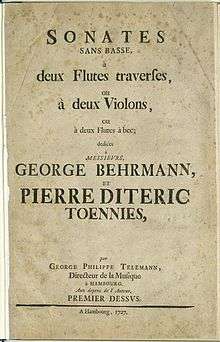Sonates sans basse (Telemann)

The title page of the original 1727 print of Georg Philipp Telemann's Sonates sans basse for two flutes, violins, or recorders (TWV 40:101–106), first published in Hamburg in 1727, reads: "Sonates sans basse à deux Flutes traverses, ou à deux Violons, ou à deux Flutes à bec <…> par George Philippe Telemann <…> Hambourg, 1727".[1] The six sonatas consist of four movements each, and are catalogued[2][3] in the following tonalities: (1.) G major, (2.) D major, (3.) A major, (4.) E minor, (5.) B minor, (6.) E major.
“Extraordinarily effective on a variety of instruments, these works are now undoubtedly the most widely played instrumental duets from the eighteenth century <...and are...> among the composer’s best-known music during his lifetime.”[4] The collection was reprinted three times: by Le Cène (1729, Amsterdam), Le Clerc (1736–37, Paris), and Walsh (1746, London).
Steven D. Zohn writes,
The six duets all follow the same four-movement scheme in which a slow movement in variable style leads to a fugue, a slow movement in the Affettuoso mode, and a light finale that is usually dance based. Telemann goes to great lengths to ensure the equality of the two parts: neither is restricted to providing accompaniment to the other for more than a few measures at a time, and even sequential figuration tends to be divided between the parts though frequent voice exchange. Canonic writing, useful for involving both parts equally in the presentation of thematic material, is employed in many movements but never overused <…>[4]
Telemann composed five collections of duets of particular significance to flutists:
- TWV 40:101-106 "Sonates sans basse" (Op.2; 1727) [in 4 movements each]
- TWV 40:118-123 "XIIX Canons mélodieux" (Op.5; 1738) [in 3 movements each]
- TWV 40:124–29 "Second livre de duo" (c. 1750) [in 3 movements each]
- TWV 40:130-135 "Sei duetti..." (c.>1752) [in 4 movements each]
- TWV 40:141-149[5] (Nine Sonatas for Two Transverse Flutes) [in 3 or 4 movements each] (re-)discovered in the musical archive of the Sing-Akademie zu Berlin in 2002. The last three (TWV 40:147-149) are of dubious authorship due to their "less polished and imaginative" quality.[6]
Additionally, Telemann's 1728-1729 periodical "Der getreue Music-Meister" contains an idiomatic "Duetto" in four movements (TWV 40:107).
References
- ↑ "6 Sonatas, TWV 40:101-106 (Telemann, Georg Philipp) First Edition, Hamburg: l'auteur, 1727.". IMSLP. Retrieved April 21, 2016.
- ↑ RISM ID no.: 452513673—Manuscript: 1800 [without title], Staatsbibliothek zu Berlin - Preußischer Kulturbesitz, Musikabteilung (D-B) Mus.ms. 21787/1 https://opac.rism.info/search?id=452513673
- ↑ RISM ID no.: 453002252—Manuscript: 1740-1760 “6. Duetto.”, Badische Landesbibliothek, Musikabteilung (D-KA) Mus. Hs. 274 https://opac.rism.info/search?id=453002252
- 1 2 Zohn, Steven D. (2008). Music for a Mixed Taste: Style, Genre, and Meaning in Telemann's Instrumental Works. New York: Oxford University Press. pp. 391–393. ISBN 9780195169775.
- ↑ RISM ID no.: 469390300—Sing-Akademie zu Berlin, Notenarchiv (D-Bsa) https://opac.rism.info/search?id=469390300
- ↑ Steven Zohn's liner notes to the CD recording Telemann: Flute Duets TWV 40:141-146; Steven Zohn and Colin St-Martin, baroque flutes; © 2011 Centaur Records, Inc.
External links
- 6 Sonatas, TWV 40:101-106: Scores at the International Music Score Library Project
- Dr. Steven Zohn page at Temple University https://www.temple.edu/boyer/about/people/stevenzohn.asp
- Zohn, Steven D. Music for a Mixed Taste: Style, Genre, and Meaning in Telemann's Instrumental Works. New York: Oxford University Press, 2008. https://global.oup.com/academic/product/music-for-a-mixed-taste-9780195169775?cc=us&lang=en&